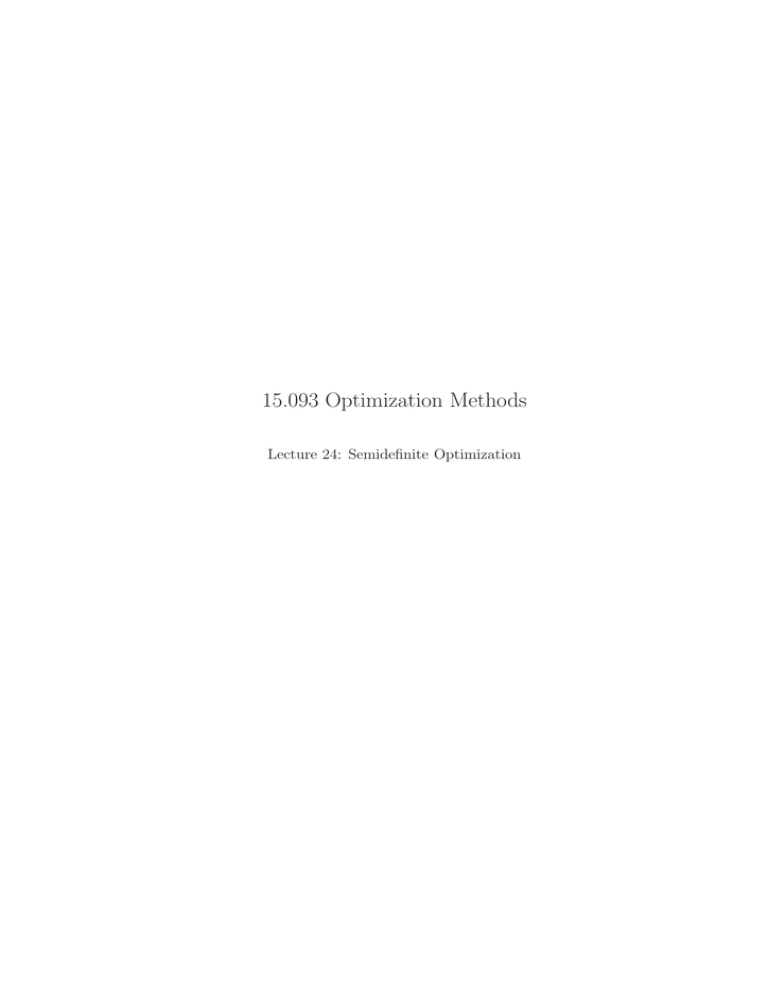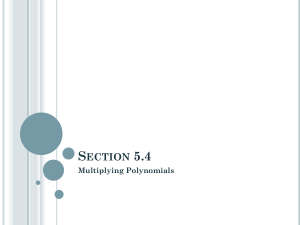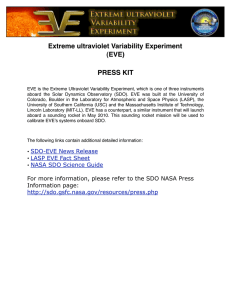15.093 Optimization Methods Lecture 24: Semidefinite Optimization
advertisement

15.093 Optimization Methods Lecture 24: Semidefinite Optimization 1 Outline Slide 1 1. Minimizing Polynomials as an SDP 2. Linear Difference Equations and Stabilization 3. Barrier Algorithm for SDO 2 SDO formulation 2.1 Primal and dual • (P ) : Slide 2 min C • X s.t. Ai • X = bi X�0 • (D) : m � max i = 1, . . . , m yi bi i=1 s.t. C − m � yi Ai � 0 i=1 3 Minimizing Polynomials 3.1 Sum of squares Slide 3 • A polynomial f (x) is a sum of squares (SOS) if � gj2 (x) f (x) = j for some polynomials gj (x). • A polynomial satisfies f (x) ≥ 0 for all x ∈ R if and only if it is a sum of squares. • Not true in more than one variable! 3.2 Proof • (⇐) Obvious. If f (x) = Slide 4 � 2 j gj (x) then f (x) ≥ 0. 1 � � • (⇒) Factorize f (x) = C j (x − rj )nj k (x − ak + ibk )mk (x − ak − ibk )mk . Since f (x) is nonnegative, then C ≥ 0 and all the nj are even. Then, f (x) = f1 (x)2 + f2 (x)2 , where f1 (x) = C2 1 � = 1 2 � j f2 (x) C j 3.3 (x − rj ) (x − rj ) nj 2 � nj 2 � k (x − ak )mk k bm k k SOS and SDO Slide 5 • Let zx = (1, x, x2 , . . . , xk )� . • f (x) = z(x)� Qz(x) is a sum of squares if and only if f (x) = z(x)� Qz(x), where Q � 0, i.e., Q = L� L. • Then, f (x) = z(x)� L� L(x) = ||Lz(x)||2 . 3.4 Formulation Slide 6 • Consider min f (x). • Then, f (x) ≥ γ if and only if f (x) − γ = zx� Qzx with Q � 0. This implies linear constraints on γ and Q. • Reformulation max γ s.t. 3.5 3.5.1 � f (x) − γ = z(x)� Qz(x) Q � 0 Example Reformulation Slide 7 min f (x) = 3 + 4x + 2x2 + 2x3 + x4 . f (x) − γ = 3 − γ + 4x + 2x2 + 2x3 + x4 = (1, x, x2 )� Q(1, x, x2 ). max s.t. γ 3 − γ = q11 4 = 2q12 , 2 = 2q13 + q22 2 = 2q ⎡23 , 1 = q33 ⎤ q11 q12 q13 Q = ⎣ q12 q22 q23 ⎦ � 0 q13 q23 q33 Extensions to multiple dimensions. 2 4 Stability Slide 8 • A linear difference equation x(k + 1) = Ax(k), x(0) = x0 • x(k) converges to zero iff |λi (A)| < 1, i = 1, . . . n • Characterization: |λi (A)| < 1 ∀i ⇐⇒ ∃P � 0 A� P A − P � 0 4.1 Proof Slide 9 • (⇐=) Let Av = λv. Then, 0 > v � (A� P A − P )v = (|λ|2 − 1) �v ��� P v, � >0 and therefore |λ| < 1 �∞ � • (=⇒) Let P = i=0 Ai QAi , where Q � 0. The sum converges by the eigenvalue assumption. Then, � A PA − P = ∞ � i� i A QA − i=1 4.2 ∞ � � Ai QAi = −Q � 0 i=0 Stabilization Slide 10 • Consider now the case where A is not stable, but we can change some elements, e.g., A(L) = A + LC, where C is a fixed matrix. • Want to find an L such that A + LC is stable. • Use Schur complements to rewrite the condition: (A + LC)� P (A + LC) − P � 0, P �0 � � � P (A + LC)� P �0 P (A + LC) P Condition is nonlinear in (P , L) 4.3 Changing variables Slide 11 • Define a new variable Y := P L � � P A� P + C � Y � �0 P A + Y C P • This is linear in (P , Y ). • Solve using SDO, recover L via L = P −1 Y 3 5 Primal Barrier Algorithm for SDO Slide 12 • X � 0 ⇔ λ1 (X) ≥ 0, . . . , λn (X) ≥ 0 • Natural barrier to repel X from the boundary λ1 (X) > 0, . . . , λn (X) > 0: − n � log(λi (X)) = j=1 − log( n � λi (X)) = − log(det(X)) j=1 Slide 13 • Logarithmic barrier problem min s.t. Bµ (X) = C • X − µ log(det(X)) Ai • X = bi , i = 1, . . . , m, X �0 • Derivative: �Bµ (X) = C − µX −1 Follows from log det(X + H ) ≈ log det(X) + trace(X −1 H ) + · · · • KKT conditions Ai • X = bi , i = 1, . . . , m, m � C − µX −1 = yi A i . i=1 X � 0, • Given µ, need to solve these nonlinear equations for X, C, yi • Apply Newton’s method until we are “close” to the optimal • Reduce value of µ, and iterate until the duality gap is small 5.1 Another interpretation Slide 14 • Recall the optimality conditions: m � = bi , i = 1, . . . , m, Ai • X yi A i + S =C X, S XS � 0, =0 i=1 • Cannot solve directly. Rather, perturb the complementarity condition to X S = µI. • Now, unique solution for every µ > 0 (the “central path”) • Solve using Newton, for decreasing values of µ. 4 6 Differences with LO Slide 15 • Many different ways to linearize the nonlinear complementarity condition X S = µI • Want to preserve symmetry of the iterates • Several search directions. 7 Convergence 7.1 Stopping criterion Slide 16 • The point (X, yi ) is feasible, and has duality gap: C •X − m � i=1 yi bi = µX −1 • X = nµ • Therefore, reducing µ always decreases the duality gap �√ �0 � • Barrier algorithm needs O iterations to reduce duality gap from �0 n log � to � 8 Conclusions Slide 17 • SDO is a powerful modeling tool • Barrier and primal-dual algorithms are very powerful • Many good solvers available: SeDuMi, SDPT3, SDPA, etc. • Pointers to literature and solvers: www-user.tu-chemnitz.de/~helmberg/semidef.html 5 MIT OpenCourseWare http://ocw.mit.edu 15.093J / 6.255J Optimization Methods Fall 2009 For information about citing these materials or our Terms of Use, visit: http://ocw.mit.edu/terms.





